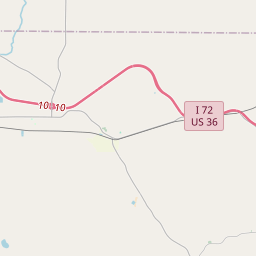First Baptist Church
Historical marker location:
Barry, Illinois
( Marker is at the intersection of Main Street and Rodgers Street, on the right when traveling west on Main Street.)







© OpenStreetMap contributors
Loading...
Searching for other points of interest within 3 miles of this location.The first McDonald's restaurant was opened in Des Plaines, Illinois in 1955. The restaurant was designed to be a drive-in, but it quickly became popular with families and eventually evolved into the fast-food chain we know today.
About Pike County
Pike County Timeline
Pike County, Illinois has a rich and diverse history that spans back centuries. The area was originally inhabited by Native American tribes, including the Illini and Kickapoo tribes, who utilized the abundant natural resources of the region. European settlers began to arrive in the late 18th century, attracted by the fertile land and access to transportation routes such as the Mississippi River.
The county was officially established in 1821 and was named after Zebulon Pike, a famous explorer. It quickly became known for its agriculture, with crops such as corn and wheat being grown on the fertile soil. The county also had a vibrant timber industry, as the dense forests provided valuable timber for construction and fuel.
In the mid-19th century, Pike County faced its most significant historical event - the infamous Mormon War. The conflict arose between the Mormon settlers, led by Joseph Smith, and the local residents who opposed their religious beliefs and practices. The tensions escalated to violence, resulting in several deaths and the eventual expulsion of the Mormons from the county.
Throughout the 20th century, Pike County continued to thrive as an agricultural community. However, its economy diversified with the growth of industries such as coal mining, oil drilling, and manufacturing. Today, Pike County is known for its scenic beauty, outdoor recreational opportunities, and vibrant community. Its rich history is celebrated through various historic sites, museums, and annual events that offer visitors a glimpse into the county's past.
The county was officially established in 1821 and was named after Zebulon Pike, a famous explorer. It quickly became known for its agriculture, with crops such as corn and wheat being grown on the fertile soil. The county also had a vibrant timber industry, as the dense forests provided valuable timber for construction and fuel.
In the mid-19th century, Pike County faced its most significant historical event - the infamous Mormon War. The conflict arose between the Mormon settlers, led by Joseph Smith, and the local residents who opposed their religious beliefs and practices. The tensions escalated to violence, resulting in several deaths and the eventual expulsion of the Mormons from the county.
Throughout the 20th century, Pike County continued to thrive as an agricultural community. However, its economy diversified with the growth of industries such as coal mining, oil drilling, and manufacturing. Today, Pike County is known for its scenic beauty, outdoor recreational opportunities, and vibrant community. Its rich history is celebrated through various historic sites, museums, and annual events that offer visitors a glimpse into the county's past.
Pike County Timeline
This timeline provides a condensed summary of the historical journey of Pike County, Illinois.
- 1821: Pike County was officially established on January 31st
- 1824: The first settlers arrived in the area
- 1828: The county's first courthouse was built in Atlas
- 1833: The county seat was permanently moved to Pittsfield
- 1835: The first newspaper, the Pike County Free Press, was published
- 1843: The first railroad, the Northern Cross Railroad, reached Pittsfield
- 1858: Abraham Lincoln, then a candidate for the U.S. Senate, delivered his famous "House Divided" speech in Pittsfield
- 1879: Pike County suffered a devastating tornado that caused significant damage and loss of life
- 1918: Pike County experienced an influenza pandemic, which resulted in numerous deaths
- 1940s-1950s: Pike County saw a decline in population as many residents migrated to urban areas
- 1987: The Pike County Historical Society was established to preserve the county's history